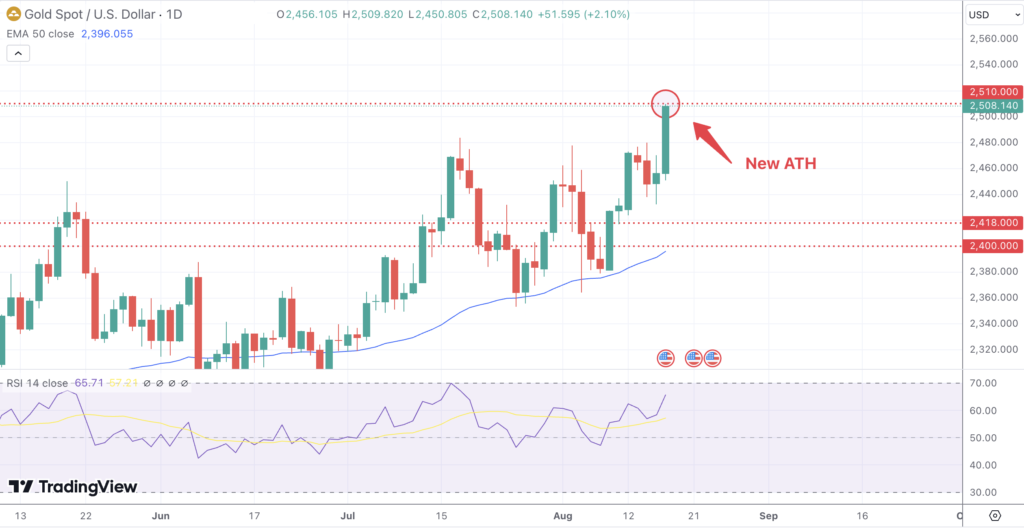Key Takeaways
- Gold has recently crossed the $2,500 mark, with a bullish bias prevailing in the market.
- The Jackson Hole symposium, featuring remarks from Fed Chair Jerome Powell, is expected to be a key event influencing gold prices.
- Technical indicators suggest that gold remains in an upward trend, with potential resistance at $2,550 and $2,600.
- Geopolitical tensions, particularly in the Middle East, have bolstered gold’s appeal as a safe-haven asset.
- The market expects the Fed to begin a rate-cutting cycle in September, which could further support gold’s price.
Market Dynamics and Recent Performance
The gold market has been marked by significant developments over the past week, driven by both technical patterns and geopolitical tensions. Gold prices have recently crossed the $2,500 mark, maintaining a bullish bias despite facing some resistance in sustaining momentum. As the market anticipates the Jackson Hole symposium, where Federal Reserve Chair Jerome Powell is expected to speak, the precious metal’s price movements have remained closely tied to investor expectations surrounding U.S. monetary policy and geopolitical risks.
During the past week, gold’s price action has been somewhat detached from traditional market drivers such as the U.S. dollar and bond yields. Instead, it has been influenced primarily by headline risks and technical factors. The ongoing geopolitical turmoil, particularly in the Middle East, has further enhanced gold’s appeal as a safe-haven asset, providing additional support for the metal’s upward trajectory.
Technical and Fundamental Influences
From a technical perspective, gold is trading within an ascending channel, with the path of least resistance currently appearing to be upward. Key support levels have been identified around $2,418 and $2,400, while resistance is pegged at the recent highs near $2,510. If gold manages to break above this level decisively, the next targets could be $2,550 and potentially $2,600. The 14-day Relative Strength Index (RSI) suggests that gold remains a ‘buy-the-dip’ asset, with momentum indicators pointing to the possibility of further gains in the near term.

On the fundamental side, the anticipation of a dovish shift by the Federal Reserve, as indicated by recent U.S. inflation data, has been a critical factor in supporting gold prices. The Producer Price Index (PPI) and Consumer Price Index (CPI) for July showed easing inflationary pressures, reinforcing the market’s expectation that the Fed may commence a rate-cutting cycle as early as September. Such a move would likely weaken the U.S. dollar further and provide additional upside potential for gold.
Geopolitical factors have also played a significant role in shaping gold’s outlook. The conflict between Israel and Hamas, coupled with concerns over Iran’s involvement, has heightened market fears of a broader regional escalation. This uncertainty has driven increased demand for gold, reinforcing its status as a hedge against political and economic instability.
Looking Forward
As the new week begins, all eyes will be on the Jackson Hole symposium, where Jerome Powell’s remarks could offer crucial insights into the Federal Reserve’s future policy direction. If Powell signals a commitment to easing monetary policy, gold could see further gains. However, any hawkish undertones could temper the metal’s upward momentum.
In addition to Fed policy, ongoing geopolitical tensions will continue to influence gold prices. Should the situation in the Middle East escalate, gold could see a surge in demand, pushing prices higher. Conversely, any resolution or de-escalation of these tensions might lead to a short-term pullback.

